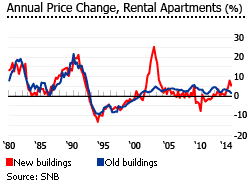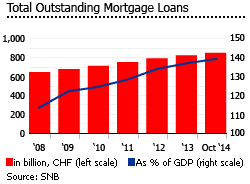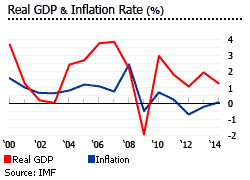Swiss housing market slowing sharply
Switzerland’s property market is now slowing sharply, amidst economic slowdown and the government’s efforts to cool the market.
- Owner-occupied apartment prices were up by 2.15% (2.09% inflation-adjusted) in 2014 from a year earlier, the lowest annual increase since 2006, according to the Swiss National Bank (SNB).
- Single-family home prices increased slightly by 1.08% (1.02% inflation-adjusted) in 2014 from the previous year, down from annual rises of 4.65% in 2013, 3.74% in 2012, 4.10% in 2011, 4.66% in 2010 and 5.04% in 2009.

Rental apartments showed the same trend. The average price of rental apartments rose by 1.93% (1.87% inflation-adjusted) y-o-y in 2014, according to the SNB. Old rental apartments gained 1.83% (1.77% inflation-adjusted) y-o-y in 2014, while new rental apartment prices rose by 5.22% (5.16% inflation-adjusted).
The property market's slowdown can be attributed to efforts by the federal government and the Swiss National Bank to cool the market by stricter lending criteria and lowering housing debt (which currently makes up about 90% of all household debt).
“This development is long overdue,” said Dominik Matter of Fahrländer Partner. “Prices have reached such high levels in certain geographic areas and market segments that households simply could no longer afford them.”
- Northwestern Switzerland recorded the biggest price gain in owner-occupied apartments, at 4.12% (4.06% inflation-adjusted) y-o-y in 2014.
- Southern Switzerland had an annual house price increase of 3.52% (3.46% inflation-adjusted).
- Central Switzerland had a house price increase of 3.01% (2.95% inflation-adjusted).
- Eastern Switzerland had a house price increase of 2.33% (2.27% inflation-adjusted)
- Western Switzerland had a house price increase of a meagre 0.15% (o.09% inflation-adjusted).
Some regions are now experiencing falling house prices. In 2014, the Berne area saw an annual house price drop of 2.21% (-2.27% inflation-adjusted); Lake Geneva area prices fell 0.89%, and Zurich area prices fell 0.84%.
The Swiss property market is expected to continue slowing this year, according local property experts. That's because Switzerland’s economy is expected to contract by about 0.5% this year, mainly due to falling oil prices and declining exports caused by the strengthening of the Swiss franc against major currencies. It expanded by just 1.25% in 2014, after growing by 1.9% in 2013, 1% in 2012, 1.8% in 2011 and 3% in 2010, according to the International Monetary Fund (IMF).
Despite the recent slowdown, the property market's "bubble risk" intensified in Q3 2014, rising by 4% from the previous quarter, to reach 1.29— considered in the ‘risk zone’ by UBS, who publish the bubble index.
The 2000s boom
Switzerland’s housing market saw strong house price increases from 2000 to 2012:
- Owner-occupied dwelling prices rose 67.2% (54% in real terms)
- Single-family home prices rose 44.9% (33.6% in real terms)
- Rental apartments in old and new buildings had price growth of 44% (32.7% in real terms)

The robust price increases were due to SNB’s monetary easing in the late 90s and early 2000s. From a peak of more than 7% (1990 to 1992), mortgage rates dropped to an average of 4.3% in 2000-2001, and 3% from 2003 to 2006.
These interest rate reductions contributed greatly to the recovery after the great housing crash of the 1990s, with residential property prices bottoming out between 1999 and 2000.
Investors quickly snapped up new units when it was clear the housing market was recovering, as new units earn higher rents. The old rental apartments index rose 29.4% (18.9% in real terms) from 2000 to 2008, but the new rental apartments index rose an astonishing 51% (38.6% in real terms). There was a huge jump from mid-2001 to 2002, when the new rental apartments index rose 17.8% y-o-y, while the old rental apartments index rose by a mere 3%.

Developers responded by increasing the supply of new rental units. Owners of old units also refurbished or renovated their units. The increase in competition led to slower price increases and eventually price falls for new units.
House price rises slowed sharply in the second half of 2008, due to the global crisis. They increased in 2009-10, albeit at a much slower pace, and accelerated again in 2011, as global economy started to recover.Mortgage interest rates are amazingly low

In October 2014, variable mortgage rates averaged 2.69%, unchanged from a year earlier, according to SNB.
Fixed mortgage rates continued to fall:
- The average interest rates for mortgage loans with a maturity of up to 1 year fell to 1.3% from 1.42% a year ago.
- For loans with a maturity of up to 3 years, the average mortgage rate moved to 1.22% in October 2014 from 1.32% in October 2013.
- For loans with maturity of up to 7 years, the average mortgage rate fell to 1.41% in October 2014 from 1.82% a year earlier.
- For loans with maturity of up to 10 years, the average mortgage rate also dropped to 2.03% in October 2014 from 2.68% a year earlier.
In February 2013, the Federal Council decided to implement a countercyclical capital buffer (CCB) to prevent the real estate market from further overheating. From September 30, 2013 banks were required to hold 1% of the risk-weighted assets in their mortgage portfolios. As a result, mortgage interest rates started to rise in 2013, but never rose above 3%. Mortgage rates dropped again in 2014.
From about 2.96% in September 2008, SNB reduced its key rate (3-month Libor) to almost 0% (0.005% in August 2011). In December 2014, the central bank’s key rate fell to -0.063%. Switzerland’s low interest rates were also a result of SNB’s attempt to contain Swiss franc appreciation. The variable mortgage rate followed suit, and was 2.69% in November 2014, almost unchanged since December 2011.
Swiss lenders are generally conservative. Borrowers must produce down payments of 20% to 5% of loan value. In 2004, 91% of all bank mortgages had loan-to-value (LTV) ratios of less than two-thirds of the property value.
Mortgage market remains highly leveraged

By end-2014, the size of Switzerland's mortgage market was around 140% of GDP, far higher than the about 75% of GDP in 2000 and just 60% of GDP in 1990, based on figures from the SNB.
Outstanding mortgage loans amounted to CHF 849.55 billion (€812 billion) in October 2014, up by about 4% from the same period last year, and up by 175% since 2000.
Foreigners are settling in Switzerland in large numbers
Switzerland has the world’s largest number of permanent immigrants per capita in 2012, based on the 2014 International Migration Outlook compiled by the Organisation for Economic Cooperation and Development (OECD), at 23.3% of the population. This is significantly affecting house price movements. Europeans account for 85% of the permanent foreign resident population.

Foreign residents tend to remain ‘foreign’, because Switzerland has one of the world’s strictest citizenship requirements. It requires 12 years of “permanent, legal, notated” residency, full integration to Swiss culture and community, and mastery of one of the official languages.
The annual increase of permanent foreign residents has risen sharply, from an average of 21,360 1999-2006, to 67,622 in 2008, with some fallback after that. In 2012 the net increase in permanent foreign residents was 53,975.
Due to the increase, Switzerland introduced new quotas for EU citizens in 2013:
- For the 17 older EU states, long-term residence permits are capped at 53,700 for 12 months from June 1.
- The number of long term residence permits for immigrants from Czech Republic, Estonia, Hungary, Latvia, Lithuania, Poland, Slovakia, and Slovenia will be capped at 2,180.
- Immigration from the two newest EU states - Bulgaria and Romania, is severely restricted.
These quotas can only last for 12 months in accordance to the freedom of movement rules signed by Switzerland in 1999.
In February 2014, the government proposed slashing net immigration to no more than 0.2% of the population, which would have required net immigration to fall from around 80,000 people to just 16,000 every year. However in November 2014 this immigration cap was rejected, with 74% of the people voting ‘no’ in a referendum.
Foreign property purchases severely restricted
The Swiss have long restricted the sale of property to foreigners. Cantonal authorization is needed before gaining title. Each canton has slightly different rules and the rules even vary from commune to commune within the canton. In addition, the Federal government has set an annual quota of permits for non-resident foreigners seeking to acquire property in Switzerland.
Generally speaking, foreigners have the largest choice of properties in French-speaking cantons. The most liberal canton is Vaud, which includes mountain resorts such as Villars, where foreigners can buy virtually any property and resell immediately.
Low rental yields; buy-to-let is not for foreigners
Rental yields in Switzerland’s major cities are quite low. In Geneva, home to several international organizations, i.e. Red Cross, WTO, WHO and ILO, rental apartments yield from 2.83% to 3.08%. Smaller apartments have higher rental yields as compared to their larger counterparts.
Zurich, Switzerland’s biggest city and the financial capital, have higher gross rental yields for apartments than in Geneva. Yields ranges from 2.9% to 3.9%, according to the Global Property Guide research of August 2013.
The buy-to-let market remains off-limits to foreigners, except for subsidized housing. The acquisition of residential real estate by foreigners for rental “requires prior authorization and is prohibited because there are no grounds for granting authorization,” according to the Federal Office of Justice.
A foreigner may be granted authorization to acquire a rental unit if he constructs subsidized housing, i.e. for the building of accommodation with a rent which is low and reasonable compared with similar premises in the same locality, or to acquire newly built housing of the same type when there is a local housing shortage. This reason applies only in cantons Fribourg, Geneva, Grisons, Jura, Neuchâtel, Ticino, Vaud and Valais.
Pro-tenant laws
Switzerland has one of the lowest owner-occupancy rates in Europe. However, there has been a trend to greater home ownership, which increased from 31% of the total in 1990, to about 44% in 2014, according to figures from the Eurostat and the Freddie Mac. Changes in pension laws helped - funds can now be withdrawn for house purchases from all pension accounts, both mandatory and voluntary. However, the proportion of renters remains high at around 56.2%.
One reason is extremely pro-tenant laws. Rent increases must be justified by the landlord’s cost increases. Tenants are also protected against eviction.
Owner-occupancy is also discouraged by taxation; property is treated as an asset subject to both wealth tax, and to income tax for imputed rental income. Income tax rates in Switzerland can easily exceed 50%, among the highest in the world. Capital gains are also taxed at cantonal level, with rates differing by duration of ownership.
Swiss Franc's stunning rise

On January 15, 2015 the Swiss franc soared against major currencies when the SNB removed its CHF1.20 = EUR 1 exchange rate cap. Immediately the Swiss franc gained 39% against the euro and almost 30% against the US dollar.
The cap was introduced in 2011, when investors fled the crisis-torn Euro for Swiss assets. Switzerland's exporters cried foul when the Swiss franc rose past the US$1.10 mark in March 2011. It went to US$1.20 in June 2011 during the Greek sovereign-debt crisis. It surged to US$1.30 in August 2011.
The exchange rate cap stopped the appreciation of the domestic currency against major currencies.
However recently the SNB decided to abandon the cap in face of monetary easing by the European Central Bank (ECB), believing that increased demand for safe haven currencies such as the Swiss franc would make it impossible to defend the cap.
Swiss economy will slip into recession in 2015

Switzerland’s economy expanded by just 1.25% in 2014, after growing by 1.9% in 2013, 1% in 2012, 1.8% in 2011 and 3% in 2010, according to the International Monetary Fund (IMF). The economic growth forecast for 2015 was cut from the initial 1.9% to -0.5%, mainly due to the 'franc-shock' and falling oil prices, according to the KOF Swiss Economic Institute.
"The direct effect on the Swiss business cycle of the increase in the value of the franc will be felt on the export market," KOF said. "The Swiss economy is expected to experience a short recession in the summer semester of 2015.”
Economic growth was relatively strong from 2004 to 2007, with average annual GDP growth of 3.2%. However with the global financial crisis, economic growth slowed to 2.2% in 2008. By the 4th quarter of 2008 Switzerland was in recession. GDP contracted by as much as 1.9% in 2009, before returning to positive growth in 2010.
In 2014, the overall unemployment rate stood at about 3.4%, up from 3.2% in 2013, 2.9% in 2012 and 2.8% in 2011, according to the IMF. The country’s jobless rate is expected to remain 3.4% this year and to increase to 4.1% in 2016, according to KOF.
In December 2014, consumer prices dropped by 0.3% from the same period last year, after an annual deflation of 0.1% in the previous month, according to the Swiss Federal Statistical Office. From 2000 to 2013, Switzerland has an average inflation rate of just 0.7%, according to the IMF.